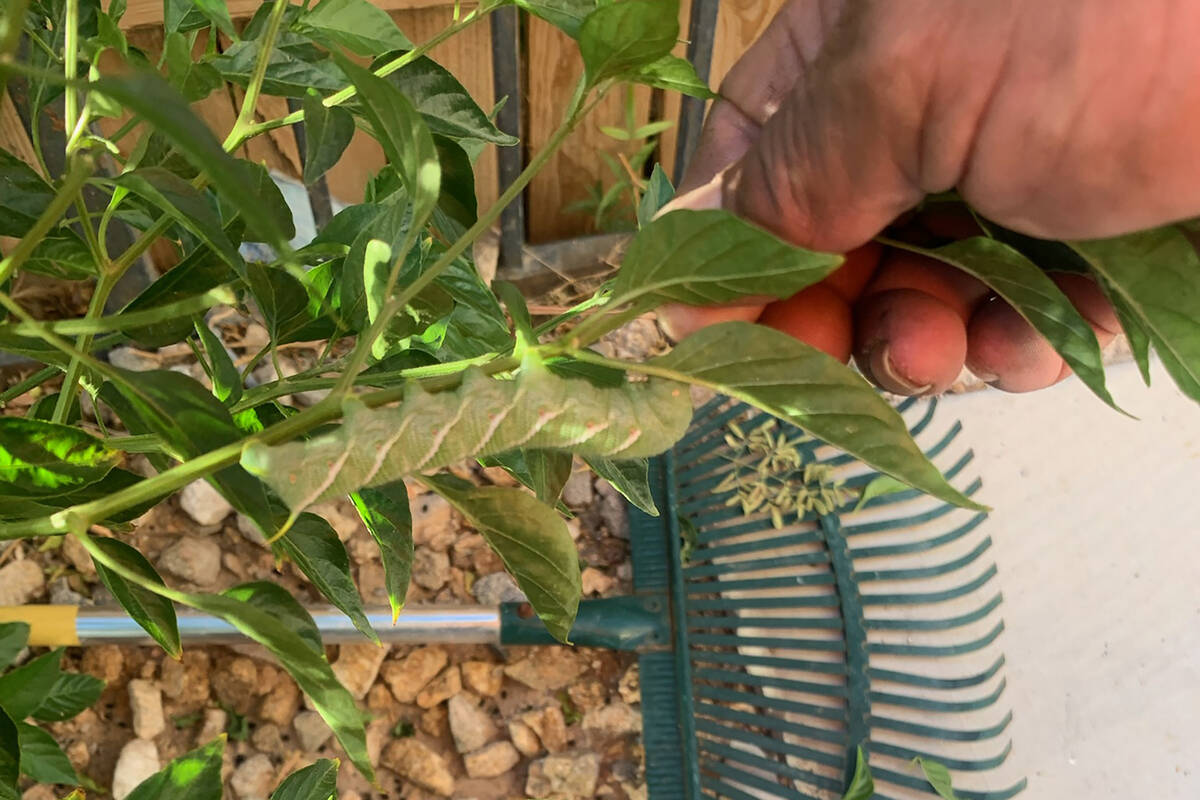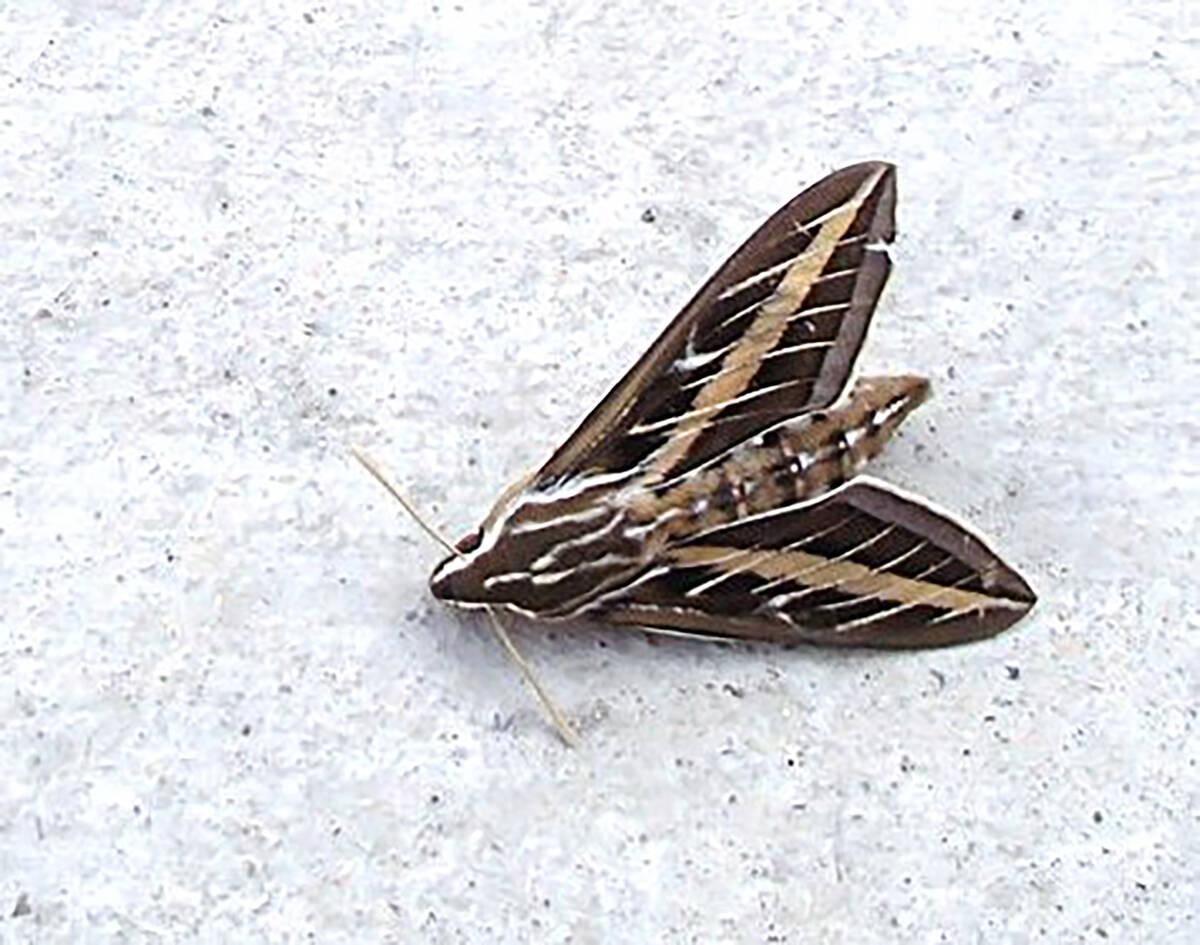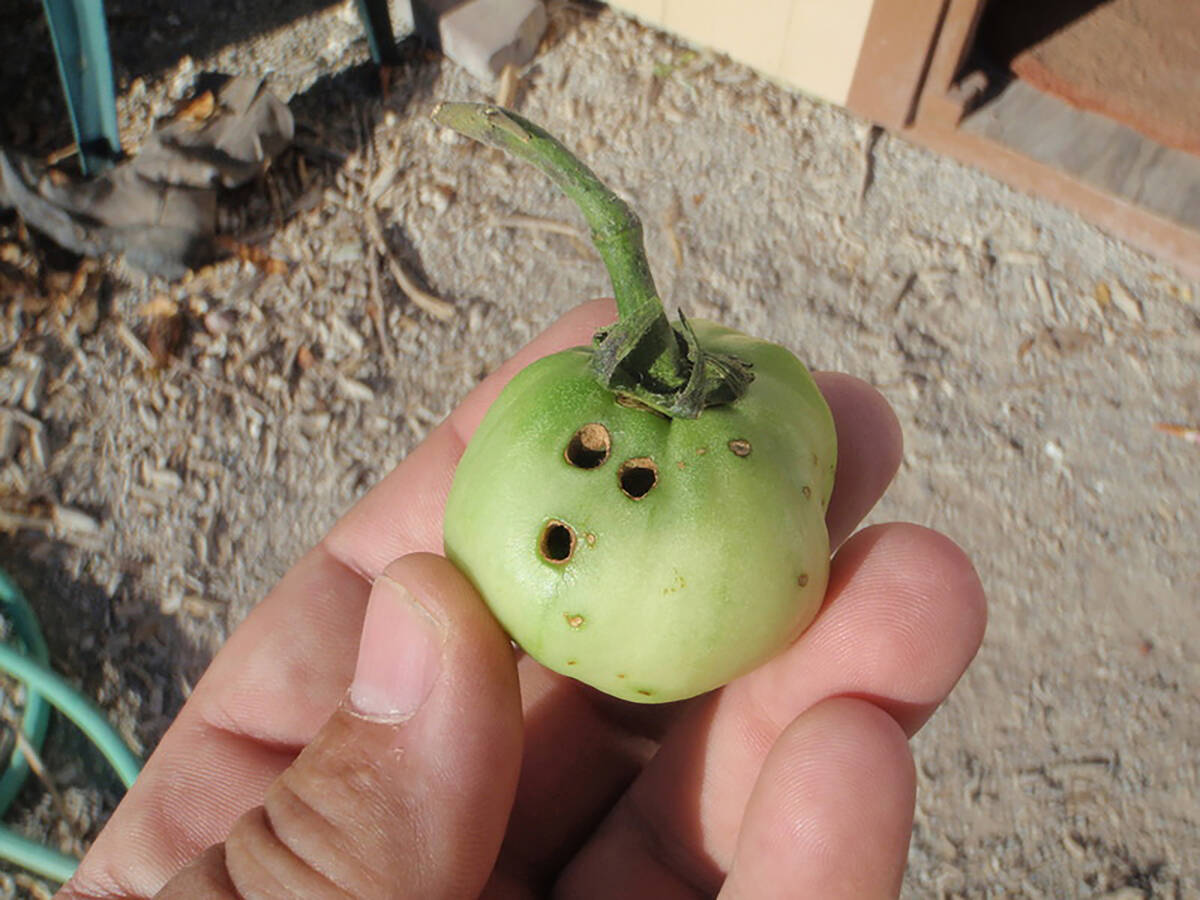Watch out for hornworms lurking in your garden
Q: What kinds of caterpillars should I be controlling now? I know they will start becoming a problem soon.
A: The principal insect that infests many vegetables in the tomato family, as well as grapes, is the hornworm. If the fruit is not yet present, they will feed on the leaves. Once the fruit is formed, watch out!
A hornworm usually has a spine on its rump and can get as big around as your thumb and about 4 inches long. The adults will be present now.
About a month or two from now I will stand still for about 15 seconds until I see leaves move. That movement signals that I missed one and it will be thumb-sized.
Anyone who has been gardening for a while has a horror story or two about hornworms.
The tomato hornworm that causes damage is the immature form, the larva (caterpillar), of the adult moth. The adult form, the hummingbird moth (or sphinx moth), normally hovers around plants (like a hummingbird) when it starts to get dark. The moth causes no damage. In fact, it is intriguing to watch. But the hornworm larvae follow, and they get bigger and bigger.
Another worm or caterpillar that causes problems is the much smaller tomato fruit worm (aka corn earworm), which is much less of a problem for us than the hornworms. It will feed on the leaves as well but prefers to make holes in the fruit of tomatoes, peppers and eggplant.
Both are controlled with the same products, either Bt (Bacillus thuringiensis, a natural control product) or Spinosad (another natural control product) sprays or dusts. The spray lasts about seven to 14 days depending on the weather. Start spraying soon after you plant tomatoes and repeat Bt sprays about one week apart or more often.
Spinosad lasts longer. Spray about three weeks apart. Make sure to cover the undersides of leaves. It may pay to add a sticker/spreader to the spray mix.
Q: I’ve been growing about 25 tomato and pepper plants for over 20 years in town. I’ve always just guessed, and some years are better than others, but I wonder how much water I need to get the max effect without wasting the water? How many times a day in the spring when I’ve just planted and how many minutes on each setting? Also, in the hot summer, I do cover the tomatoes so they don’t get sunburned.
A: I can only guess. No one has “discovered” the water use of vegetables in Las Vegas, much less what happens to tomato water use when the plant is covered.
Probably what is more important is the quality of the vegetables and how they are managed (fertilizer, thinning, shading by neighboring plants, etc.). When covering vegetables, use 30 percent to 40 percent shade cloth.
I can tell you how I water them. With warm-season crops, they need warm soil. I warm the soil with clear plastic before planting. I use half-inch drip tubing with built in emitters, 12 inches apart.
I “triangulate” the location of the emitters so I get better distribution of water. The drip lines are also installed 12 inches apart and pulled tight. I use emitter spacing for planting distances. When they are just seedlings, I water and fertilize them (every three to four weeks) to get growth. When plants are mature, I water them until the soil is full of water. Then I wait for the plant to use up the water.
Plant water use is dictated by four factors: how bright it is, wind speed, temperature and humidity. Research has discovered how to apply these four factors enter into a mathematical equation to predict water use of a specific plant.
This plant’s water use is then multiplied by another number to list a specific plant’s water use (such as tomatoes, eggplant, peppers, etc.) Each vegetable has specific water use (and plant size) that must be “discovered” by research. This depends on the plant’s size, vigor and other factors.
Q: I’m getting ready to plant a small plot of fescue from seed. Do you recommend any soil amendments for a healthy lawn?
A: Not really if the soil is workable when it’s wet. Core aerating (later) will open the soil and help the roots grow deep.
I am assuming you are using tall fescue. Select expensive grass seed. Seed at a rate no less than 7 to 8 pounds of seed for every 1,000 square feet of lawn area.
Seed of all types likes a firm seed bed. Not hard but firm. Clean up (free of weeds) the area to be seeded. All seeds prefer to grow in contact with the soil. Cover the soil and seed with no more than a quarter inch of sand or compost. Irrigate until you see standing water and then stop. Do this twice a day, morning and afternoon, to get the seed to germinate. Once the seed germinates, water next when your footprints on the grass stay lying down. Seed in February-April or late September-early November. Avoid germinating the seed during the heat of summer.
When you construct the lawn area, make sure it is at least 10 feet by 10 feet and square or at least rectangular. Water does not travel easily in other than straight lines. If you use any curves, make them gentle and big so they are easier to water.
After you mow it three or four times, rent a core aerator and bring cores to the surface. Rake them up. Follow that with a fertilizer high in phosphorus.
If you install the irrigation system yourself, make sure to check the pressure. The irrigation heads should spray water from one head to the neighboring heads. Unless it is always windy or watering a 30 percent slope. Then irrigation heads are closer than that.
This is called head-to-head coverage. For the best water management, level the soil. A tall fescue lawn will need 7 to 8 feet of water every year. You will apply more water than that because the uniformity of your irrigation system (how evenly water is applied) is 60 percent to 70 percent.
The best irrigation heads (stationary pop-ups) for tall fescue growing in smaller areas should pop up to 4 inches above the lawn and be flush with the surrounding soil.
After the lawn is established (mowed three or four times), 12 to 15 minutes per day (this time can be split into multiple sessions with an hour or less between them) is usually long enough. Change the days per week only, not the number of minutes. Water early in the morning (after 2 or 3 a.m.), and finish watering before the wind of the day starts (sunrise). Don’t water at nightfall or you may get a lawn disease.
Fertilize the lawn four times each year, and avoid the heat of summer. Core aerate once a year. Never ever mow to a height of less than 1½ inches.
Q: What should I be doing now to control borers in my African sumac?
A: Imidacloprid can be used protectively or if the landscape borer problem is present. If the borer has caused extensive damage, you might have to weigh whether it is worth applying or not. Sometimes replacing the tree is the easier solution.
Unlike peach tree borers, the boring insect is in the tree, not the soil.
Use insecticides or pesticides that contain imidacloprid as an active ingredient. The imidacloprid liquid mix can be used as a soil drench only if it says so on the label. For me, soil drenches are the most effective way to apply it because plant roots were designed for the uptake of liquids.
To avoid potentially harming honeybees, make applications after the tree has finished flowering. African sumac flowers during the winter, so the time to apply a root drench is anytime after growth begins in the spring.
Bob Morris is a horticulture expert and professor emeritus of UNLV. Visit his blog at xtremehorticulture.blogspot.com. Send questions to Extremehort@aol.com.






























